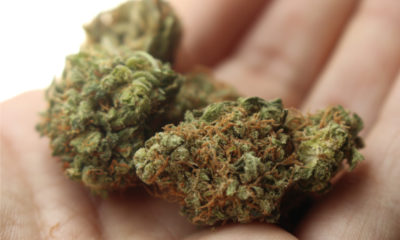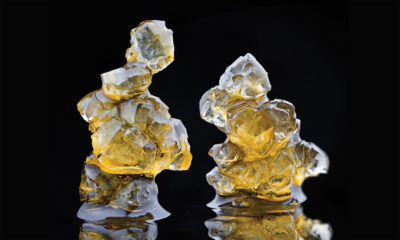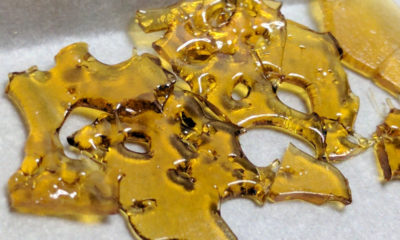
Concentrates
The Definitive History of Live Resin
Initially coined in 2013, the definition of wet plant extraction varies from state to state.
The term live resin was coined by Colorado hash legend Kind Bill in the summer of 2013. It originally referred specifically to the butane hash oil (BHO) made from fresh frozen trim, a process that’s been around since the early 1990s, when Kenneth Morrow of the infamous Trichome Technologies began employing and writing about it.
In Colorado, fresh frozen (also called wet plant extraction) is an extremely popular hash making technique for cold water and BHO hashes. In this process, fresh trim and/or buds are harvested and immediately frozen – usually in glass tubes for BHO blasting or bags for cold water. As with many great inventions, the fresh frozen process was discovered accidentally, when Bill needed work for his hash makers and decided to run some fresh material. After they blasted and opened the container of BHO, the whole room filled up with an incredibly rich, terpey smell. He immediately knew he was on to something.
Given that terpenes degrade extremely fast, the fresh frozen process is beneficial because it removes a much higher amount of terpenes. Imagine grinding up a bud but not rolling it up immediately – the smell begins to dissipate quickly. After this discovery, they started making all their hash this way and immediately began attracting a loyal following for their products. As word circulated through Colorado about this new style of hash making, others followed Kind Bill’s lead and began using fresh frozen trim to make their hash.
Nikka T of Essential Extracts was the first major cold water producer to pick up on the new trend. Within short order, he was winning Cannabis Cups around the nation with his delicious terpene-rich, golden melts – many of them classic “clear dome” full melts. There are dispensaries that sell what they call full melt hash. When you light it, it doesn’t come anywhere close to fully melting. True full melt will not only behave as the name suggests, it will also have a clear dome of resin which rises up from the pipe or rig when lit. This “clear dome” hash is truly the finest that the cold water world has to offer and the fresh frozen process produces some of the best versions.
The prevalence of greater amounts of fresh frozen material in Colorado was surely due to the abundance of flowers in the marketplace. This was before legalization started in 2014 and soon after there was a shortage of high-quality material to make hash. Essential Extracts even went offline briefly due to this shortage. Fortunately for hash connoisseurs in Colorado, they are back up to full production. The laws regarding vertical integration in Colorado changed on Jan. 1, 2014 and now the opposite situation is happening – markets are starting to be flooded with product, dropping wholesale prices. This is great news for concentrate makers and patients, but not so good for growers.
California started seeing “live resin” products begin to hit the shelves of dispensaries about a year ago. The meaning of live resin transformed when it hit the Golden State. Fresh frozen trim is not common in California. Dry trim, on the other hand, exists in massive amounts. The new California version of live resin was now being defined as BHO hashes that were still capable of changing form after being blasted. Until a BHO extract is taken to its final stable or “absolute” form the terpenes are in a state of flux and therefore still considered “live.” You can see this process with some shatters when upon exposure to air they begin to crystalize. This happens due to the terpenes changing form. When Kind Bill was asked about this new, expanded California definition of live resin, he said he was comfortable with it. It will be interesting to see if this new definition catches on in Colorado, Washington and other legal and medical markets.
New techniques and definitions are spread, adopted and changed at a rapid pace in this industry. One of the strongest proponents of these new definitions is a concentrate from Nectars Collective. The collective’s founder was part of making the original Holy Water before leaving and making the same product – but calling it Terp Juice. The product is made from all small buds and has a terpene content of almost 25 percent terps versus the 3-5 percent more commonly seen in most concentrates. The cost of using flowers and the small returns drive the price up to over $100 a gram to patients.
To counteract this high price point, Nectars started mixing small amounts of the juice with either a crumble or a shatter. These resulting products are labeled as jelly and nectars. These are priced around $60 gram retail. The Terp Juice is not considered live since it’s at an absolute or stable state. When mixed with the crumbles or the waxes it still will move towards its final state, thus still being live, by the California standard.
Whether you accept one or the other definition or none at all, what’s most interesting is that our industry continues to create, innovate and move forward producing amazing new versions of the cannabis products that could only be dreamed about before. Five years ago, the industry didn’t regularly engage in lab testing and now any legitimate dispensary tests its medicine. Most of the early BHO at that time was highly contaminated. Now, the quality of many BHO products, both those made from fresh frozen or dry trim, speaks for itself.
The cannabis industry continues to grow, morph and change faster than anyone can keep up with it. Our ability to change, adapt and innovate is one of our greatest strengths. This ability will allow us to face the challenges together and bring the benefits of this healing plant we all love so much to the rest of the world.
Originally published in the print edition of Cannabis Now.
TELL US, have you ever tried live resin?
























